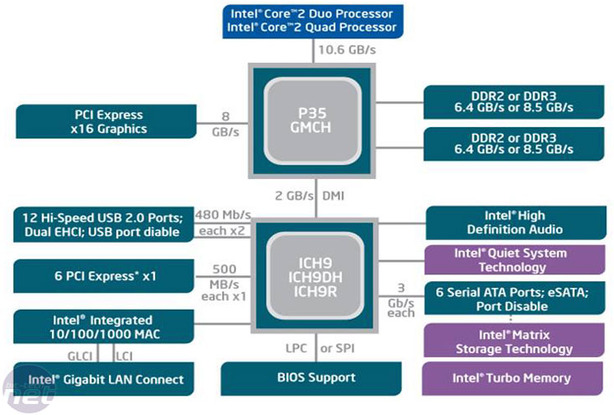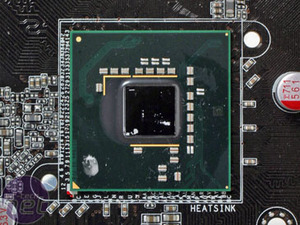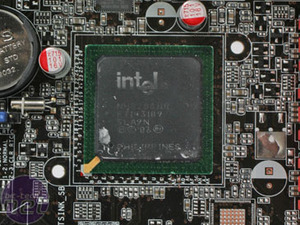Intel P35 Chipset
Continuing the tradition of yearly releases of its major chipsets, Intel is releasing its long awaited ‘Bearlake’ chipset we’ve previously heard so much about back in CeBit. Bearlake now takes the official code, P35, and is an update to the popular P965 that was released nearly a year ago.Intel likes treading in baby upgrade steps, with the chipset supporting DDR2 667/800MHz and 1066MHz unofficially, depending on vendor implementation. This is in addition to new support for DDR3 at 800/1066MHz or 1333MHz, again at the discretion of motherboard manufacturers. Motherboards can support either memory version or both if necessary. This is just like the i915 chipset, which supported both DDR and DDR2 back in 2004.
Support for both memory technologies does allow for an upgrade path to provide extra performance when DDR3 prices come down; however it’s unlikely you will be able to run DDR2 and DDR3 together. In addition, these mixed memory boards are unlikely to have the same performance as the boards dedicated to either DDR2 or DDR3, as it’s easier to optimise a BIOS for a single memory standard.
The northbridge also supports the latest quad core and 1333MHz FSB CPUs, on top of future 45nm Penryn CPUs. Due to the higher front side bus speed support, we could possibly see some even larger overclocks from current and future Core 2 CPUs. These chipsets have also been optimised to have a lower idle power, which makes them cooler and especially suitable for SFF or low power designs.

The chipset still only supports PCI-Express 1.0, and ATI CrossFire support is still a feature, albeit in a crippled fashion like it was on the P965 chipset, as it only offers an additional x4 slot to the primary x16. Enabling CrossFire is also entirely down to vendor hardware and software support, including a second PCI-Express x16 slot in its motherboard design and coding a BIOS to accept it. With the few early boards we’ve looked at, we’ve found that the assumption of CrossFire support (based on the inclusion of a second PCI-Express x16 slot) is misguided.
The upcoming X38 is due to have the upgrade to PCI-Express 2.0 which has dual x16 lanes that should excel CrossFire performance and bring it up to the same standard as all of Nvidia’s high end chipsets since nForce4 SLI x16.
Arguably the most important inclusion is support for Intel Robson technology, which now officially known as Intel Turbo Memory. This is a key feature of the brand new ‘Santa Rosa’ notebook platform that Intel released earlier this month.
Turbo Memory uses up a PCI-Express slot for 1GB of NAND flash which is split 50/50 for ReadyBoost and ReadyDrive within Windows Vista. NAND has a far higher I/O than a hard drive and is used to cache common program data to boost performance. You can use a USB stick for ReadyBoost, but the system has to interrupt itself to access the slower, shared USB bus to find the data so the performance gain isn’t as great.
While Bearlake still uses LGA775, the chipset has been optimised for the Core architecture and forgoes all support for older Pentium 4 CPUs. The southbridge has also been updated to version nine of the Intel Controller Hub (ICH) family. Twelve USB 2.0 ports are now included, however there are still only six SATA 3Gbps ports, a port multiplier and eSATA technology is a standard.
Intel continues its Matrix Storage support for RAID 0, 1, 5 and 10 and also includes six PCI-Express x1 ports in the P35 chipset. The inclusion of legacy IDE is again dropped entirely, so you're going to see third party chipsets from companies like JMicron usually employed at the discretion of manufacturers. However due to large OEMs like Dell and HP now using SATA optical drives this year should see an explosion in the marketplace.
Intel ICH9 comes under several various nomenclatures, either vanilla ICH9, ICH9R which includes Intel Matrix RAID support, ICH9DH (Digital Home) which includes Intel Matrix RAID and Intel Viiv technology or ICH9DO (Digital Office) which includes Intel Matrix RAID and Intel vPro for businesses.
The P35 is the mainstream/performance part, meaning that the ageing 975X chipset will continue to be Intel's flagship chipset until X38 arrives in week 38 (September) this year. That should bring some more fuel to the enthusiast fire.

MSI MPG Velox 100R Chassis Review
October 14 2021 | 15:04











Want to comment? Please log in.